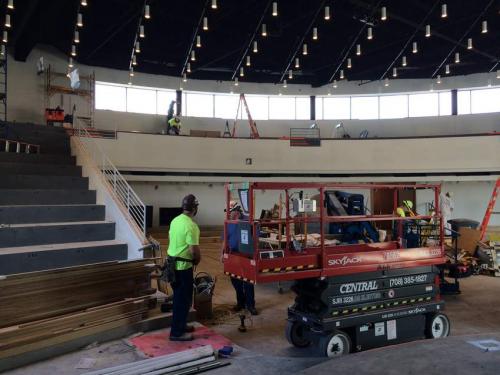Steve Sadin | For Sun-Times Media | @SadinSteve July 15 12:25 p.m.
Please click link here to go to full story in the Sun Times Media

Members of Deerfield’s B’nai Jehoshua Beth Elohim (BJBE) have a unique opportunity to put their personal touch on the building the congregation has occupied on Lake Cook Road for five years.
BJBE is completing a new sanctuary, and many people are putting a personal stamp on the place where most services will be held after it is dedicated Sept. 5-7.
Contributions have been made in many forms, from direct labor and financial gifts to in-kind donations from people affiliated with the building trades. Rabbi Karen Kedar credits communication with architect Moe Feingold as a key element in the collaborative process.
“We had a vision that was the effort of many, many conversations translated into drawings before Moe Feingold was able to make our imagination come out,” Kedar said.
Part of Kedar’s vision was the ability to have different types of communication with the congregation depending on where the person leading the group stood on the bimah (altar). There are three steps from the floor to the top.
“When you stand on the bimah, by a slight turn of your head you have immediate eye contact with all 600 people,” Kedar said. “If you go to the edge of the bimah you have a sense of conversation. If you step off, you have intimacy.”
One personal touch is coming from David and Jamie Baker of Riverwoods, who own Primrose Valley Farm in Belleville, Wisc. They donated the wood from a 100-year-old black walnut tree they had to take down on their farm, which will form the doors of the Ark.
The Ark is one of the holiest places in a synagogue, housing Torah scrolls that are the first five books of the Bible handwritten on parchment in “ornate calligraphy,” according to Kedar. The symbolism of the donated wood is multifaceted, she said.
“When you cut down a decaying tree and turn it into wood, you give it a second life,” Kedar said. “The Torah schools are (considered) a tree of life, and to have them there is really extraordinary.”
Another tree is also playing a significant role. One member donated funds for a three-dimensional metal and glass sculpture of an almond tree to cover the south window of the sanctuary.
“In Israel the almond tree is the first to bloom after winter,” Kedar said. “The tree symbolizes regeneration.”
One more feature is a unique cascade of steps and seats on the south end of the sanctuary leading to the balcony. During the current phase of construction, it looks like giant steps, but it will be finished to blend into a symbolic part of the structure. It will be called Jacob’s ladder. The significance comes from Jacob’s dream of the heavens depicted in the Bible, according to Kedar.
“In the dream the angels were ascending from the earth,” Kedar said. “Jacob’s ladder will be able to (let people) have a sense of ascension.”
Though it has only been in Deerfield for five years after moving from Glenview, BJBE has a long history that began with the founding of B’nai Jehoshua on Chicago’s south side in 1893. Beth Elohim came into existence in 1963 and the two congregations merged in 1965, according to Executive Director Arlene Mayzel.
“We have members who are descendants of the founders of B’nai Jehoshua and founding members of Beth Elohim,” Mayzel said.
When the congregation re-purposed an office building in Deerfield in 2009 into its home, it built its Sacred Hall to serve as a place for assembly and prayer. The sanctuary was initially put on hold, since the congregation chose to wait until it was financially feasible.
“We’ve been raising money ever since,” Mayzel said. “We wanted to build it out the way we (wished). We waited until it was the right time to do it.”
As excited as Kedar is about the new sanctuary, she recognizes it is just one step in the congregation’s ongoing growth. BJBE owns the building immediately to its north, which it hopes to convert into a school. Sunday school is currently held at Caruso Middle School.
“We want to bring our children home,” Kedar said.
